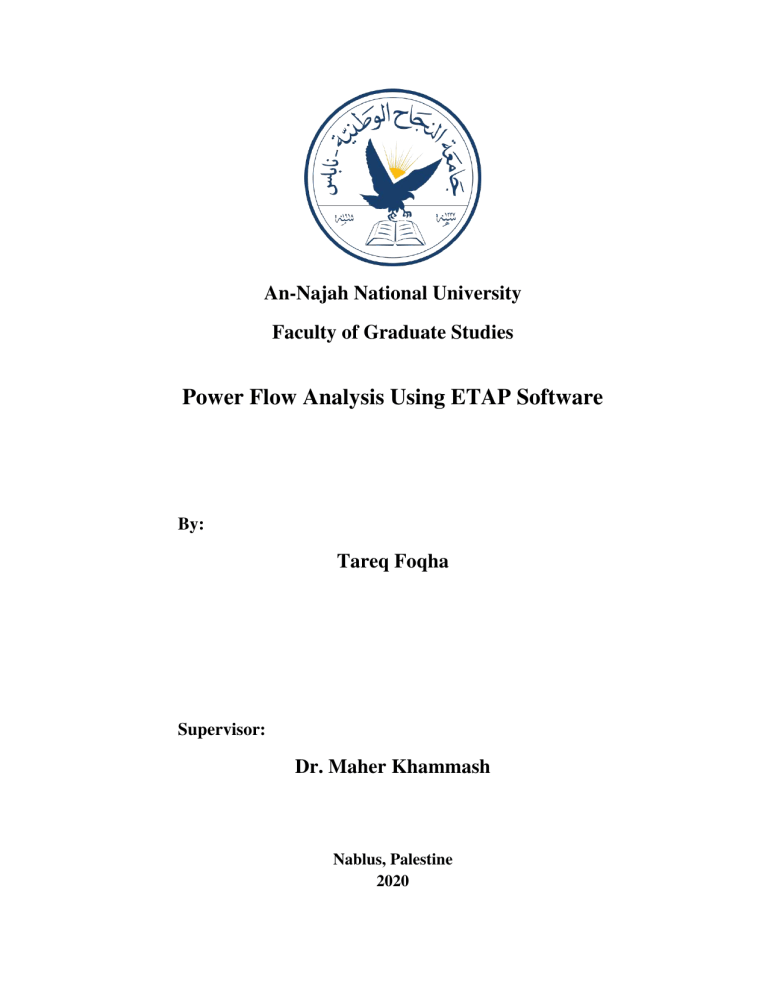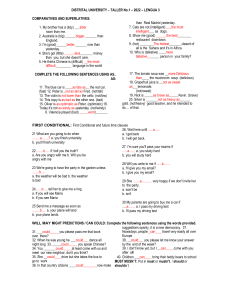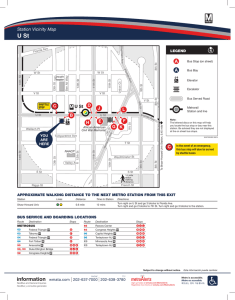
An-Najah National University Faculty of Graduate Studies Power Flow Analysis Using ETAP Software By: Tareq Foqha Supervisor: Dr. Maher Khammash Nablus, Palestine 2020 ABSTRACT Load flow is an important tool used by power engineers for planning, to determine the best operation for a power system and exchange of power between utility companies. In order to have an efficient operating power system, it is necessary to determine which method is suitable and efficient for the system’s load flow analysis. This research will introduce a load flow study and analysis for 36-bus power system using ETAP software to improve the power factor and to reduce the electrical losses. II TABLE OF CONTENTS Cover Page I Abstract II CHAPTER 1: INTRODUCTION…………………..….………………………..….……..... 1 1.1 Load Flow Studies …..….…….…………………..….……….……………..……..…..…..… 2 1.2 Newton-Raphson Power Flow Solution ………………..….……………..….……….… 4 1.3 Control of Power Flow …………………..…………………………………..…………....… 6 1.4 ETAP ………………………………………..……………..….…………………………....….… 7 CHAPTER 2: LOAD FLOW ANALYSIS .…..…..………..…..…..…..…...…...……... 8 2.1 Power System Description ……………….....….…………….……….…..……….….……. 9 2.2 Load Flow Analysis for the 36-Bus System (normal condition) …...…….……… 9 2.3 Load Flow Analysis for the 36-Bus System (Maximum Load Condition) ….… 11 The Maximum Load Improvement ….………….………….………….……………... 12 2.3.1.1 Improvement by increasing the swing bus voltage ….……………..……… 13 2.3.1.2 Improvement by Using Tap-Changing Transformers ….……………..…… 15 2.3.1.3 Improvement by Using Shunt Capacitor Banks ….……………..…………. 17 2.3.1.4 Comparison between the three cases ….……………..………….….……….. 21 2.4 Load Flow Analysis For the 36-Bus System (Minimum Load Condition) ….... 22 The Minimum Load Improvement ….………….………….………….………….….. 24 2.4.1.1 Improvement by increasing the swing bus voltage ….………….….……... 25 2.4.1.2 Improvement by Using Tap-Changing Transformers ….……….….……... 27 Load Flow Analysis For the 36-Bus System (Post Fault Condition) ..….……...…. 28 The Post Fault Condition Improvement ….……………..………...….……………..... 31 2.5.1.1 Improvement by Using Shunt Capacitor Banks ….……………..………... 31 CHAPTER 3: CONCLUSION …………..…..…..…..…..…..…..…..…..…...…..…..……... 34 3.1 Conclusion …………………..….…………….……………....….…..……………….....……… 35 BIBLIOGRAPHY ………..….……...…………………..…………....….…..……..………….....……. 36 APPENDICES …………..….……...………………………………....….…..……………….....……… 37 2.3.1 2.4.1 2.5 2.5.1 III CHAPTER ONE INTRODUCTION 1 CHAPTER ONE INTRODUCTION 1.1 Power Flow Studies: Power flow (or load flow) is the solution for the normal balanced three-phase steady-state operating conditions of an electric power system. In general, power flow calculations are performed for power system planning and operational planning, and in connection with system operation and control. The data obtained from power flow studies are used for the studies of normal operating mode, contingency analysis, outage security assessment, and optimal dispatching and stability [1]. The main objective of the load flow analysis is to identify the potential problems, in terms of unacceptable voltage conditions, overloading of facilities, decreasing reliability, or any failure of the transmission system to meet performance criteria. After this analysis stage, the planner develops alternative plans or scenarios that not only will prevent the foreseen problems but also will best meet the long-term objectives of system reliability and economy. The effectiveness of the alternative plans is determined by load-flow, or power-flow studies under both normal and emergency operations. The load-flow programs now in use by the utilities allow the calculation of currents, voltages, and real and reactive power flows, taking into account the voltage-regulating capability of generators, transformers, synchronous condensers, specified generation schedules, as well as net interchange among interconnected systems, automatically. By changing the location, size, and number of transmission lines, the planner can achieve to design an economical system that meets the operating and design criteria [2]. 2 Successful power system operation under normal balanced three-phase steady-state conditions requires the following: 1. Generation supplies the demand (load) plus losses. 2. Bus voltage magnitudes remain close to rated values. 3. Generators operate within specified real and reactive power limits. 4. Transmission lines and transformers are not overloaded. The power-flow computer program is the basic tool for investigating these requirements. This program computes the voltage magnitude and angle at each bus in a power system under balanced three-phase steady-state conditions. It also computes real and reactive power flows for all equipment interconnecting the buses, as well as equipment losses. Both existing power systems and proposed changes including new generation and transmission to meet projected load growth are of interest. Conventional nodal or loop analysis is not suitable for power-flow studies because the input data for loads are normally given in terms of power, not impedance. Also, generators are considered as power sources, not voltage or current sources. The power-flow problem is therefore formulated as a set of nonlinear algebraic equations suitable for computer solution [3]. Every power system have a special operation of the system depend on knowing the effects of this power system with other power systems and we will have new loads ,new generating stations and new transmission lines before they are installed. The required condition according to load studies for any network which consider the most difficult are: 1. Maximum load; 2. Minimum load; 3. Faults. 3 1.2 Newton-Raphson Power Flow Solution: It is an iterative method which approximates a set of non-linear simultaneous equations to a set of linear simultaneous equations using Taylor’s series expansion and the terms are limited to the first approximation. It is the most iterative method used for the load flow because its convergence characteristics are relatively more powerful compared to other alternative processes and the reliability of Newton-Raphson approach is comparatively good since it can solve cases that lead to divergence with other popular processes. If the assumed value is near the solution, then the result is obtained very quickly, but if the assumed value is farther away from the solution then the method may take longer to converge. This is another iterative load flow method which is widely used for solving nonlinear equation. The admittance matrix is used to write equations for currents entering a power system. Equation (1) is expressed in a polar form, in which j includes bus i (1) The real and reactive power at bus i is (2) Substituting for Ii in Equation (1) from Equation (2) (3) The real and imaginary parts are separated: (4) (5) 4 The above Equation (4) and (5) constitute a set of non-linear algebraic equations in terms of |V| in per unit and δ in radians. Equation (4) and (5) are expanded in Taylor’s series about the initial estimate and neglecting all higher order terms, the following set of linear equations are obtained. In the above equation, the element of the slack bus variable voltage magnitude and angle are omitted because they are already known. The element of the Jacobian matrix are obtained after partial derivatives of Equations (15) and (16) are expressed which gives linearized relationship between small changes in voltage magnitude and voltage angle. The equation can be written in matrix form as: (6) J1, J2, J3, J4 are the elements of the Jacobian matrix. The difference between the schedule and calculated values known as power residuals for the terms ∆Pi(k) and ∆Qi(k) is represented as: (7) 5 (8) The new estimates for bus voltage are [4]: (9) (10) 1.3 Control of Power Flow: The following means are used to control system power flows: 1. Prime mover and excitation control of generators. 2. Switching of shunt capacitor banks, shunt reactors, and static var systems. 3. Control of tap-changing and regulating transformers. From the power-flow standpoint, an increase in prime-move power corresponds to an increase in P at the constant-voltage bus to which the generator is connected. The power-flow program computes the increase in d along with the small change in Q. An increase in generator excitation corresponds to an increase in voltage magnitude at the constant-voltage bus to which the generator is connected. The power-flow program computes the increase in reactive power Q supplied by the generator along with the small change in δ. The addition of a shunt capacitor bank to a load bus corresponds to the addition of a negative reactive load, since a capacitor absorbs negative reactive power. The power-flow program computes the increase in bus voltage magnitude along with the small change in δ. Similarly, the addition of a shunt reactor corresponds to the addition of a positive reactive load, wherein the power-flow program computes the decrease in voltage magnitude. 6 Tap-changing and voltage-magnitude-regulating transformers are used to control bus voltages as well as reactive power flows on lines to which they are connected. Similarly, phase-angle regulating transformers are used to control bus angles as well as real power flows on lines to which they are connected. Both tap-changing and regulating transformers are modeled by a transformer with an off-nominal turns ratio c. A change in tap setting or voltage regulation corresponds to a change in c. The power-flow program computes the changes in Ybus, bus voltage magnitudes and angles, and branch flows [3]. 1.4 ETAP: Electrical Transient Analyzer Program (ETAP) is the foremost-integrated for electrical systems allowing to have multiple representations of a power system for different analysis and design purpose. This research will introduce the load flow studies for various conditions by Electrical Transient Analyzer Program (ETAP) application software as a successful and accurate tool to conduct load flow study of complex electrical power systems within the minimum time period. 7 CHAPTER TWO LOAD FLOW ANALYSIS 8 CHAPTER TWO LOAD FLOW ANALYSIS 2.1 System Description: The one line diagram of a 36-bus system is shown in Figure 1. The System data needed for power flow are shown in appendix A. In this system one generator placed at bus number 36. In short, this network consists of 36 buses, 35 branches, and 35 loads as presented in table (1). Buses Branches Generators System Description Swing Regulated Load Transmission Lines Transformers 1 Loads 1 0 35 18 17 30 2.2 Load Flow Analysis For the 36-Bus System (normal condition): For load flow analysis we used the Newton Raphson method with max number of iterations of 50 and precision of 0.0001. Figure 2 shows the normal load flow analysis, after we run the program the results are obtained from ETAP are shown in tables 2 and 3. Other results are shown in Appendix A. Bus Number Bus Type 1 2 3 4 5 6 Load Bus Load Bus Load Bus Load Bus Load Bus Load Bus Nominal Voltage % Angle 89.078 -5.6 86.527 -5.2 86.193 -5.1 86.193 -5.1 86.132 -5.1 86.098 -5.1 9 PF 69.9 69.9 70.4 75.5 64.6 73.9 7 8 9 10 11 12 13 14 15 16 17 18 19 20 21 22 23 24 25 26 27 28 29 30 31 32 33 34 35 36 Load Bus Load Bus Load Bus Load Bus Load Bus Load Bus Load Bus Load Bus Load Bus Load Bus Load Bus Load Bus Load Bus Load Bus Load Bus Load Bus Load Bus Load Bus Load Bus Load Bus Load Bus Load Bus Load Bus Load Bus Load Bus Load Bus Load Bus Load Bus Load Bus Slack Bus 86.106 86.202 86.321 86.170 86.393 85.526 86.495 85.558 86.007 85.129 85.116 85.110 85.416 76.747 81.932 82.863 80.874 79.266 77.474 79.511 80.147 79.804 78.101 78.909 78.488 78.444 76.979 76.674 77.168 100.00 -5.1 -5.1 -5.1 -5.1 -5.1 -5.0 -5.1 -4.9 -5.0 -4.8 -4.8 -4.9 -4.9 -9.3 -6.7 -5.7 -7.2 -9.1 -9.5 -8.8 -7.5 -8.4 -10.2 -8.7 -9.5 -8.9 -9.5 -9.5 -9.8 0.0 66.9 74.4 60.8 68.7 71.4 67.5 68.6 68.0 67.5 68.0 66.6 70.9 61.5 67.4 70.7 75.5 65.6 78.4 70.7 72.9 64.0 70.7 74.6 70.7 70.7 71.5 72.0 70.7 74.9 62.3 Table (2) Summary of total generation, loading and demand are shown in the following table: Source (Swing Bus) Total Demand Total Losses MW 143.465 143.465 8.407 Mvar 180.335 180.335 48.888 Table (3) MVA 230.440 230.440 PF 62.26 lagging 62.26 lagging We conclude that all voltages are less than the nominal voltage. And there is a high voltage drop and transmission losses. 10 Figure (1): 36-bus power system. 2.3 Load Flow Analysis For the 36-Bus System (Maximum Load Condition): In this section maximum load state will be studied and we will see the optimization problems and will search solution for this optimization problem; and obtain results and make recommendations. 11 Figure (2): Load Flow Analysis in normal condition. 2.3.1 The Maximum Load Improvement When the original condition analyzed we noticed that there is a drop voltage in most of the buses. The calculated voltages shown in the table are not acceptable because of the extra drop voltage in the networks; and the voltages should be adjusted to Vmax = (105% - 110%) Vnominal. This is required in max load for better performance of the network, because of the drop in voltage; we have three methods to increase the voltage on the buses: 12 1. Increasing the swing bus voltage; 2. Tap changing Transformers; 3. Addition of a shunt capacitor bank to a load bus 2.3.1.1 Improvement by increasing the swing bus voltage: For this network we assume that we can increase the voltage on the swing bus up to 5% from the nominal voltage (220 kV), the new value of the swing bus voltage will be (231 kV), After running the ETAP the load flow results obtained are shown in the tables 4 and 5, other results are shown in the appendix B, Figure 3 shows the load flow analysis after increasing the swing bus voltage by 5%. Bus Number Bus Type 1 2 3 4 5 6 7 8 9 10 11 12 13 14 15 16 17 18 19 20 21 22 23 24 Load Bus Load Bus Load Bus Load Bus Load Bus Load Bus Load Bus Load Bus Load Bus Load Bus Load Bus Load Bus Load Bus Load Bus Load Bus Load Bus Load Bus Load Bus Load Bus Load Bus Load Bus Load Bus Load Bus Load Bus Nominal Voltage % Angle 94.680 -5.6 92.246 -4.7 91.926 -4.7 91.926 -4.7 91.868 -4.6 91.838 -4.7 91.845 -4.6 91.935 -4.7 92.049 -4.7 91.905 -4.6 92.117 -4.7 91.292 -4.5 92.214 -4.6 91.322 -4.5 91.763 -4.6 90.928 -4.4 90.917 -4.4 90.911 -4.4 91.203 -4.4 83.043 -8.3 87.870 -6.1 88.750 -5.2 86.873 -6.5 85.379 -8.2 13 PF 70.1 70.2 70.4 75.5 64.7 74.4 67.4 74.7 61.1 68.9 71.7 67.9 68.9 68.4 68.0 68.4 67.1 71.4 62.2 67.4 70.7 75.5 65.6 78.4 25 26 27 28 29 30 31 32 33 34 35 36 Load Bus Load Bus Load Bus Load Bus Load Bus Load Bus Load Bus Load Bus Load Bus Load Bus Load Bus Slack Bus 83.709 85.603 86.192 85.875 84.303 85.036 84.656 84.606 83.260 82.977 83.440 105.000 -8.5 -7.9 -6.8 -7.6 -9.2 -7.8 -8.6 -8.1 -8.6 -8.6 -8.9 0.0 70.7 72.9 64.0 70.7 74.6 70.7 70.7 71.5 72.0 70.7 74.9 63.2 Table (4) Figure (3): Load flow analysis after increasing the swing bus voltage by 5%. 14 Summary of total generation, loading and demand are shown in the following table: MW 145.585 145.585 7.598 Source (Swing Bus) Total Demand Total Losses Mvar 178.444 178.444 44.148 Table (5) MVA 230.440 230.440 PF 63.22 lagging 63.22 lagging The increasing of the swing bus voltage by 5% didn’t achieve the required, so we have to change the tap changer. 2.3.1.2 Improvement by Using Tap-Changing Transformers: In this network the max tap of the transformer T20 is +1 x 5% and the rest of the transformers have max tap of +1 x 2%, so we put the settings of the transformers tap’s as shown in the following table: Transformer Tap Settings T20 -4% on the primary Side Other transformers -1% on the primary Side Table (6) After running the ETAP the load flow results obtained are shown in the tables 7 and 8, other results are shown in the appendix C, Figure 4 shows the load flow analysis after changing the tap as shown in table 6. 15 Figure (4): Load flow analysis after Changing the Tap of the transformers. Bus Number Bus Type 1 2 3 4 5 6 7 8 9 10 11 12 13 Load Bus Load Bus Load Bus Load Bus Load Bus Load Bus Load Bus Load Bus Load Bus Load Bus Load Bus Load Bus Load Bus Nominal Voltage % Angle 99.474 -4.7 97.123 -4.4 96.813 -4.3 96.813 -4.4 96.757 -4.3 96.730 -4.3 96.736 -4.3 96.822 -4.3 96.933 -4.3 96.793 -4.3 96.998 -4.4 96.201 -4.2 97.092 -4.3 16 PF 70.4 70.4 70.4 75.5 64.8 74.8 67.7 74.9 61.4 69.1 71.9 68.2 69.1 14 15 16 17 18 19 20 21 22 23 24 25 26 27 28 29 30 31 32 33 34 35 36 Load Bus Load Bus Load Bus Load Bus Load Bus Load Bus Load Bus Load Bus Load Bus Load Bus Load Bus Load Bus Load Bus Load Bus Load Bus Load Bus Load Bus Load Bus Load Bus Load Bus Load Bus Load Bus Slack Bus 96.231 96.663 95.859 95.848 95.842 96.124 89.357 93.912 94.748 92.965 91.561 89.990 91.772 92.323 92.026 90.564 91.222 90.891 90.819 89.556 89.290 89.728 105.00 -4.2 -4.3 -4.1 -4.1 -4.2 -4.1 -7.6 -5.6 -4.8 -6.0 -7.5 -7.8 -7.3 -6.2 -6.9 -8.4 -7.2 -7.8 -7.4 -7.9 -7.8 -8.1 0 68.7 68.4 68.8 67.5 71.8 62.7 67.4 70.7 75.5 65.6 78.4 70.7 72.9 64.0 70.7 74.6 70.7 70.7 71.5 72.0 70.7 74.9 63.9 Table (7) Summary of total generation, loading and demand are shown in the following table: Source (Swing Bus) Total Demand Total Losses MW 147.947 147.947 7.045 Mvar 177.921 177.921 40.817 Table (8) MVA 231.396 231.396 PF 63.94 lagging 63.94 lagging The changing of the tap on the transformers still didn’t achieve the required, so we have to add shunt capacitor banks. 2.3.1.3 Improvement by Using Shunt Capacitor Banks: After running the ETAP the load flow results obtained are shown in the tables 9 and 10, other results are shown in the appendix D, Figure 5 shows the network after adding the capacitor bank and Figure 6 shows the load flow analysis after installing the capacitor banks. 17 This equation will be used to calculate the reactive power needed from the capacitors: Qc= P(tan cos-1 (PFold) - tan cos-1(PFnew)) PFnew (desired) = 0.94 lag Table (9) shows the voltage level before and after adding the capacitors: Bus Number Bus Type QC Mvar 1 2 3 4 5 6 7 8 9 10 11 12 13 14 15 16 17 18 19 20 21 22 23 24 25 26 27 28 29 30 31 32 33 34 35 36 Load Bus Load Bus Load Bus Load Bus Load Bus Load Bus Load Bus Load Bus Load Bus Load Bus Load Bus Load Bus Load Bus Load Bus Load Bus Load Bus Load Bus Load Bus Load Bus Load Bus Load Bus Load Bus Load Bus Load Bus Load Bus Load Bus Load Bus Load Bus Load Bus Load Bus Load Bus Load Bus Load Bus Load Bus Load Bus Slack Bus 1.9111 1.7980 1.3399 1.7840 3.1000 1.9110 8.6389 1.95556 9.3594 2.0613 2.2910 2.4210 2.0778 5.2780 0.3824 0.1163 1.0947 1.0291 3.5689 1.7164 0.8376 1.7207 4.4229 3.9067 4.6842 4.1007 4.5665 4.8434 4.1664 - Nominal Voltage before adding capacitor bank % 99.474 97.123 96.813 96.813 96.757 96.730 96.736 96.822 96.933 96.793 96.998 96.201 97.092 96.231 96.663 95.859 95.848 95.842 96.124 89.357 93.912 94.748 92.965 91.561 89.990 91.772 92.323 92.026 90.564 91.222 90.891 90.819 89.556 89.290 89.728 105.00 Table (9) 18 Nominal Voltage after adding capacitor bank % 105.570 103.875 103.654 103.641 103.606 103.568 103.568 103.668 104.018 103.750 103.710 103.130 103.834 103.202 103.527 102.936 102.937 102.904 103.152 101.519 102.914 102.778 102.944 101.417 101.565 102.186 102.881 102.431 101.700 101.938 102.198 101.779 101.093 101.104 100.877 105.000 PFold PFnew 70.4 70.4 70.4 75.5 64.8 74.8 67.7 74.9 61.4 69.1 71.9 68.2 69.1 68.7 68.4 68.8 67.5 71.8 62.7 67.4 70.7 75.5 65.6 78.4 70.7 72.9 64.0 70.7 74.6 70.7 70.7 71.5 72.0 70.7 74.9 63.9 94.6 94.7 94.9 94.8 88.7 92.4 93.4 99.0 94.2 94.0 94.0 93.6 94.1 93.5 92.9 93.1 93.2 92.9 92.5 94.5 94.9 94.6 95.1 94.3 94.5 94.6 95.2 94.7 94.8 94.6 94.7 94.5 94.3 94.3 94.2 90.7 Summary of total generation, loading and demand are shown in the following table: Source (Swing Bus) Total Demand Total Losses MW 149.626 149.626 3.595 Mvar 71.177 71.177 20.772 Table (10) MVA 165.699 165.699 Figure (5): 36-bus power system with capacitor banks. 19 PF 90.3 lagging 90.3 lagging Figure (6): Load flow analysis after installing the capacitor banks. We conclude that all voltages are within the specifications required in the case of maximum load. 20 2.3.1.4 Comparison between the three cases: Table (11) shows the effect on the bus voltage after using each improvement method. Bus Number Bus Type 1 2 3 4 5 6 7 8 9 10 11 12 13 14 15 16 17 18 19 20 21 22 23 24 25 26 27 28 29 30 31 32 33 34 35 36 Load Bus Load Bus Load Bus Load Bus Load Bus Load Bus Load Bus Load Bus Load Bus Load Bus Load Bus Load Bus Load Bus Load Bus Load Bus Load Bus Load Bus Load Bus Load Bus Load Bus Load Bus Load Bus Load Bus Load Bus Load Bus Load Bus Load Bus Load Bus Load Bus Load Bus Load Bus Load Bus Load Bus Load Bus Load Bus Slack Bus Normal Case Increase the voltage of swing bus by 5% Changing the tap changer and change the swing bus voltage by 5% % 89.078 86.527 86.193 86.193 86.132 86.098 86.106 86.202 86.321 86.170 86.393 85.526 86.495 85.558 86.007 85.129 85.116 85.110 85.416 76.747 81.932 82.863 80.874 79.266 77.474 79.511 80.147 79.804 78.101 78.909 78.488 78.444 76.979 76.674 77.168 100.00 % 94.680 92.246 91.926 91.926 91.868 91.838 91.845 91.935 92.049 91.905 92.117 91.292 92.214 91.322 91.763 90.928 90.917 90.911 91.203 83.043 87.870 88.750 86.873 85.379 83.709 85.603 86.192 85.875 84.303 85.036 84.656 84.606 83.260 82.977 83.440 105.000 % 99.474 97.123 96.813 96.813 96.757 96.730 96.736 96.822 96.933 96.793 96.998 96.201 97.092 96.231 96.663 95.859 95.848 95.842 96.124 89.357 93.912 94.748 92.965 91.561 89.990 91.772 92.323 92.026 90.564 91.222 90.891 90.819 89.556 89.290 89.728 105.00 Table (11): Comparison between the three cases. 21 Changing the tap changer, change the swing bus voltage by 5% and adding capacitor bank % 105.790 104.143 103.922 103.909 103.929 103.836 103.863 103.935 104.018 103.903 103.933 103.354 104.060 103.430 103.791 103.201 103.202 103.206 103.416 101.811 103.195 103.055 103.288 101.705 101.860 102.475 103.169 102.720 102.856 102.180 102.445 101.027 101.384 101.396 101.214 105.000 2.4 Load Flow Analysis For the 36-Bus System (Minimum Load Condition): In this case the network will be studied at its minimum load that the load will be decreased by 70% that we will multiply the real and reactive power by 0.3 at each load, the new data for the minimum case are shown in table (12). Bus Number Normal Case Bus Type Minimum Load 1 Load Bus P (MW) - Q (Mvar) - P (MW) - Q (Mvar) - 2 Load Bus - - - - 3 Load Bus 3.000 3.000 0.900 0.900 4 Load Bus 3.570 3.100 1.190 0.930 5 Load Bus 2.610 3.000 0.783 0.900 6 Load Bus - - - - 7 Load Bus 2.800 2.800 0.840 0.840 8 Load Bus 4.019 3.100 1.206 0.930 9 Load Bus - - - - 10 Load Bus 3.000 3.000 0.900 0.900 11 Load Bus 16.70 14.70 5.010 4.410 12 Load Bus 3.070 3.070 0.921 0.921 13 Load Bus 14.66 14.68 4.398 4.893 14 Load Bus 3.330 3.270 0.999 0.981 15 Load Bus - - - - 16 Load Bus 3.800 3.670 1.140 1.101 17 Load Bus 3.800 3.800 1.140 1.140 18 Load Bus 4.000 3.530 1.200 1.059 19 Load Bus - - - - 20 Load Bus 7.200 7.900 2.16 2.37 21 Load Bus 0.600 0.600 0.18 0.18 22 22 Load Bus 0.230 0.200 0.069 0.06 23 Load Bus 1.390 1.600 0.417 0.48 24 Load Bus 2.400 1.900 0.720 0.570 25 Load Bus 5.600 5.600 1.68 1.68 26 Load Bus 2.980 2.800 0.984 0.934 27 Load Bus 1.000 1.200 0.3 0.36 28 Load Bus 2.700 2.700 0.810 0.810 29 Load Bus 8.350 7.450 2.505 2.235 30 Load Bus 6.130 6.130 1.839 1.839 31 Load Bus 7.350 7.350 2.205 2.205 32 Load Bus 6.670 6.530 2.001 1.959 33 Load Bus 7.600 7.330 2.280 2.199 34 Load Bus 7.600 7.600 2.280 2.280 35 Load Bus 8.000 7.070 2.400 2.121 36 Slack Bus 0.384 1.920 0.1152 0.576 Total Number of buses = 36 144.543 140.6 45.595 42.318 Table (12): New Load values for minimum load condition. Figure 7 shows the load flow analysis for minimum load condition, after we run the program the results are obtained from ETAP are shown in tables 13 and 14. Other results are shown in Appendix E. Bus Number Bus Type 1 2 3 4 5 6 7 8 9 10 11 12 Load Bus Load Bus Load Bus Load Bus Load Bus Load Bus Load Bus Load Bus Load Bus Load Bus Load Bus Load Bus Nominal Voltage % Angle 97.186 -1.6 96.393 -1.6 96.300 -1.5 96.185 -1.6 96.283 -1.5 96.278 -1.6 96.278 -1.5 96.298 -1.6 96.337 -1.6 96.294 -1.5 96.450 -1.5 96.215 -1.5 23 PF 77.4 77.3 70.6 95.7 65.4 77.4 69.9 74.7 63.3 70.2 73.2 70.0 13 14 15 16 17 18 19 20 21 22 23 24 25 26 27 28 29 30 31 32 33 34 35 36 Load Bus Load Bus Load Bus Load Bus Load Bus Load Bus Load Bus Load Bus Load Bus Load Bus Load Bus Load Bus Load Bus Load Bus Load Bus Load Bus Load Bus Load Bus Load Bus Load Bus Load Bus Load Bus Load Bus Slack Bus 96.478 96.224 96.363 96.126 96.123 96.121 96.205 93.996 95.150 95.276 94.880 94.502 94.065 94.260 94.698 94.698 94.622 94.334 94.414 94.388 94.055 93.981 94.109 100.00 -1.5 -1.5 -1.5 -1.5 -1.5 -1.5 -1.5 -2.5 -1.9 -1.7 -2.1 -2.5 -2.6 -2.5 -2.1 -2.3 -2.7 -2.4 -2.6 -2.4 -2.6 -2.6 -2.6 0 70.4 70.6 70.7 71.1 69.8 74.0 66.0 67.4 70.7 75.5 65.6 78.4 70.7 70.7 64.0 70.7 74.6 70.7 70.7 71.5 72.0 70.7 74.9 71.2 Table (13) Summary of total generation, loading and demand are shown in the following table: Source (Swing Bus) Total Demand Total Losses MW 45.4 45.4 0.642 Mvar 45.228 45.228 3.688 Table (14) MVA 64.084 64.084 PF 70.84 lagging 70.84 lagging We have to increase the buses voltage up to 100%, for this case firstly we will increase the swing bus voltage to 5%. 2.4.1 The Minimum Load Improvement When the minimum load condition analyzed we noticed that there is a drop voltage in most of the buses. The calculated voltages shown in the table are not acceptable because of the extra drop voltage in the networks; and the voltages should be adjusted to Vmax = (100%) Vnominal. 24 This is required in minimum load for better performance of the network, because of the drop in voltage; we have three methods to increase the voltage on the buses: 1. Increasing the swing bus voltage; 2. Tap changing Transformers; 3. Addition of a shunt capacitor bank to a load bus Figure (7): Load flow analysis for minimum load condition. 2.4.1.1 Improvement by increasing the swing bus voltage: For this network we assume that we can increase the voltage on the swing bus up to 5% from the nominal voltage (220 kV), the new value of the swing bus voltage will be (231 kV), After 25 running the ETAP the load flow results obtained are shown in the tables 15 and 16, other results are shown in the appendix F, Figure 8 shows the load flow analysis after increasing the swing bus voltage by 5%. Bus Number Bus Type 1 2 3 4 5 6 7 8 9 10 11 12 13 14 15 16 17 18 19 20 21 22 23 24 25 26 27 28 29 30 31 32 33 34 35 36 Load Bus Load Bus Load Bus Load Bus Load Bus Load Bus Load Bus Load Bus Load Bus Load Bus Load Bus Load Bus Load Bus Load Bus Load Bus Load Bus Load Bus Load Bus Load Bus Load Bus Load Bus Load Bus Load Bus Load Bus Load Bus Load Bus Load Bus Load Bus Load Bus Load Bus Load Bus Load Bus Load Bus Load Bus Load Bus Slack Bus Nominal Voltage % Angle 102.281 -1.5 101.512 -1.4 101.422 -1.4 101.311 -1.5 101.406 -1.5 101.401 -1.4 101.401 -1.4 101.420 -1.4 101.458 -1.4 101.417 -1.4 101.568 -1.4 101.340 -1.4 101.595 -1.4 101.349 -1.4 101.484 -1.4 101.254 -1.4 101.251 -1.4 101.250 -1.4 101.331 -1.4 99.196 -2.3 100.310 -1.8 100.431 -1.6 100.048 -1.9 99.684 -2.3 99.262 -2.4 99.450 -2.3 99.873 -2.0 99.800 -2.1 99.522 -2.5 99.678 -2.2 99.599 -2.4 99.573 -2.2 99.253 -2.4 99.182 -2.4 99.305 -2.4 105.00 0 (Table 15) 26 PF 77.4 77.3 70.6 95.7 77.5 77.5 69.9 74.8 -63.3 70.3 73.3 70 70.4 70.8 70.8 71.1 69.9 74.1 66.1 67.4 70.7 75.5 65.6 78.4 70.7 70.7 64.0 70.7 74.6 70.7 70.7 71.5 72.0 70.7 74.9 74.4 Summary of total generation, loading and demand are shown in the following table: MW 46.279 46.279 0.601 Source (Swing Bus) Total Demand Total Losses Mvar 45.849 45.849 3.455 Table (16) MVA 65.145 65.145 PF 71.04 lagging 71.04 lagging The increasing of the swing bus voltage by 5% didn’t achieve the required, so we have to change the tap changer. 2.4.1.2 Improvement by Using Tap-Changing Transformers: the settings of the transformers tap’s are set as shown in the following table: Transformer Tap Settings T20 0% on the primary Side Other transformers -1% on the primary Side Table (17) After running the ETAP the load flow results obtained are shown in tables 18 and 19, other results are shown in the appendix G. If we change the tap of the transformer T20 the buses voltage will be out of the range Bus Number Bus Type 1 2 3 4 5 6 7 8 9 10 11 12 13 Load Bus Load Bus Load Bus Load Bus Load Bus Load Bus Load Bus Load Bus Load Bus Load Bus Load Bus Load Bus Load Bus Nominal Voltage % Angle 102.275 -1.5 101.505 -1.4 101.415 -1.4 101.304 -1.5 101.399 -1.5 101.393 -1.4 101.394 -1.4 101.414 -1.4 101.451 -1.4 101.410 -1.4 101.561 -1.4 101.332 -1.4 101.588 -1.4 27 PF 77.4 77.3 70.6 95.7 77.5 77.5 69.9 74.8 -63.3 70.3 73.3 70 70.4 14 15 16 17 18 19 20 21 22 23 24 25 26 27 28 29 30 31 32 33 34 35 36 Load Bus Load Bus Load Bus Load Bus Load Bus Load Bus Load Bus Load Bus Load Bus Load Bus Load Bus Load Bus Load Bus Load Bus Load Bus Load Bus Load Bus Load Bus Load Bus Load Bus Load Bus Load Bus Slack Bus 101.341 101.476 101.246 101.243 101.241 101.323 100.225 101.334 101.453 101.074 100.712 100.292 100.480 100.900 100.827 100.554 100.704 100.631 100.601 100.280 100.209 100.331 105.00 -1.4 -1.4 -1.4 -1.4 -1.4 -1.4 -2.3 -1.8 -1.6 -1.9 -2.3 -2.3 -2.3 -1.9 -2.1 -2.5 -2.2 -2.3 -2.2 -2.3 -2.3 -2.4 0 70.8 70.8 71.1 69.9 74.1 66.1 67.4 70.7 75.5 65.6 78.4 70.7 70.7 64.0 70.7 74.6 70.7 70.7 71.5 72.0 70.7 74.9 71.4 Table (18) Summary of total generation, loading and demand are shown in the following table: Source (Swing Bus) Total Demand Total Losses MW 46.374 46.374 0.602 Mvar 45.941 45.941 3.456 Table (19) MVA 65.279 65.279 PF 71.04 lagging 71.04 lagging 2.5 Load Flow Analysis For the 36-Bus System (Post Fault Condition): In this section we will assume that the network is affected by a fault condition in some locations of the transmission lines of the network, after the fault occurs we will try to optimize the problem. Line (1-15) one of the most important lines in the network, which is carries max power as shown in figure (8). It will be assumed that a fault happened at one line of the double 28 line, because of that the resistance and inductance will be multiplied by 2 and we will divide the admittance by 2. Figure (8): Load flow analysis for post fault condition (determine the critical transmission line in the network). After we change the line 1-15 parameters as follows and run ETAP the load flow results obtained are shown in tables 20 and 21, other results are shown in the appendix H, Figure 9 shows the load flow analysis for this case. R= 0.04 new R = 0.08 X= 0.024 new X = 0.048 29 Figure (9): Load flow analysis for post fault condition Bus Number Bus Type 1 2 3 4 5 6 7 8 9 10 11 12 13 14 15 Load Bus Load Bus Load Bus Load Bus Load Bus Load Bus Load Bus Load Bus Load Bus Load Bus Load Bus Load Bus Load Bus Load Bus Load Bus Nominal Voltage % 105.470 103.774 103.553 103.540 103.504 103.466 103.493 103.566 103.649 103.533 103.609 103.028 103.733 103.100 101.281 30 16 17 18 19 20 21 22 23 24 25 26 27 28 29 30 31 32 33 34 35 36 Load Bus Load Bus Load Bus Load Bus Load Bus Load Bus Load Bus Load Bus Load Bus Load Bus Load Bus Load Bus Load Bus Load Bus Load Bus Load Bus Load Bus Load Bus Load Bus Load Bus Slack Bus 100.675 100.675 100.643 100.895 99.0160 102.807 102.672 102.835 101.308 101.453 102.076 102.771 102.322 101.589 101.828 102.087 101.669 98.6070 98.6070 98.4010 105.000 Table (20) Summary of total generation, loading and demand are shown in the following table: Source (Swing Bus) Total Demand Total Losses MW 150.055 150.055 4.477 Mvar 72.944 72.944 21.595 Table (21) MVA 166.839 166.839 PF 89.94 lagging 89.94 lagging We conclude that after the fault the voltage of some buses reduced, for this case we will add capacitor bank at bus 19 with 12 Mvar rating, 2.5.1 The Post Fault Condition Improvement 2.5.1.1 Improvement by Using Capacitor Bank: After adding a capacitor bank at bus 19 with 12 Mvar rating then running the ETAP the load flow results obtained are shown in the tables 22 and 23, other results are shown in the appendix J, Figure 10 shows the load flow analysis after installing the capacitor banks. 31 Bus Number Bus Type 1 2 3 4 5 6 7 8 9 10 11 12 13 14 15 16 17 18 19 20 21 22 23 24 25 26 27 28 29 30 31 32 33 34 35 36 Load Bus Load Bus Load Bus Load Bus Load Bus Load Bus Load Bus Load Bus Load Bus Load Bus Load Bus Load Bus Load Bus Load Bus Load Bus Load Bus Load Bus Load Bus Load Bus Load Bus Load Bus Load Bus Load Bus Load Bus Load Bus Load Bus Load Bus Load Bus Load Bus Load Bus Load Bus Load Bus Load Bus Load Bus Load Bus Slack Bus Nominal Voltage % 106.343 104.664 104.445 104.432 104.397 104.359 104.386 104.458 104.540 104.425 104.499 103.924 104.623 103.997 102.804 102.208 102.208 102.175 102.733 101.055 103.745 103.597 103.787 102.268 102.437 103.039 103.732 103.283 102.565 102.796 103.063 102.642 100.293 100.300 100.080 105.000 Table (21) Summary of total generation, loading and demand are shown in the following table: Source (Swing Bus) Total Demand Total Losses MW 150.445 150.445 4.19 Mvar 57.651 57.651 20.371 Table (22) 32 MVA 161.111 161.111 PF 93.38 lagging 93.38 lagging Figure (10): Load flow analysis for post fault condition after adding capacitor bank. 33 CHAPTER THREE CONCLUSION 34 CHAPTER THREE CONCLUSION 3.1 Conclusion: Power flow analysis is an essential step for operational purposes to evaluate various operating states of an existing system. Also it is necessary for enhancement and development projects. In this research Load flow study using ETAP software is carried out to analyze the system under various conditions. By using ETAP load flow program, it is found that the 36-bus network experiences many technical problems including: poor power factor, low voltage levels and power losses. And the aim of this load flow studies is to determining the system voltage under various conditions, and to use proper methods that used to maintain the problem of under voltage. And they are useful to determine if system voltages remain within specific limits under various conditions, and whether equipment such as transformers and transmission lines are overloaded. It is used to identify the need for additional generation, placement of shunt capacitors or reactors to maintain the system voltages within the limits. 35 BIBLIOGRAPHY [1]: Gonen, T. (2013). Modern power system analysis. CRC Press. [2]: Turan, G. (1998). Electric power transmission system engineering. [3]: Glover, J. D. D., & Sarma, M. S. (2001). Power system analysis and design. Brooks/Cole Publishing Co. [4]: Afolabi, O. A., Ali, W. H., Cofie, P., Fuller, J., Obiomon, P., & Kolawole, E. S. (2015). Analysis of the load flow problem in power system planning studies. Energy and Power Engineering, 7(10), 509. 36 Appendices Appendix (A): Normal Case A.1 Input Data Bus Input Data: 37 Branch Connections: 38 2-Winding Transformer Input Data: A.2 Load Flow Solution 39 40 A.3 Branch Losses 41 Appendix (B): Maximum Load Condition (Swing Bus) B.1 Load Flow Solution (Swing Bus) 42 43 B.2 Branch Losses (Swing Bus) 44 Appendix (C): Maximum Load Condition (Tap Changing Transformer) C.1 Load Flow Solution (Tap Changing Transformer) 45 46 C.2 Branch Losses (Tap Changing Transformer) 47 Appendix (D): Maximum Load Condition (Capacitor Bank) D.1 Load Flow Solution (Capacitor Bank) 48 49 D.2 Branch Losses (Capacitor Bank) 50 Appendix (E): Minimum Load Condition E.1 Load Flow Solution 51 52 E.2 Branch Losses 53 Appendix (F): Minimum Load Condition (Swing Bus) F.1 Load Flow Solution (Swing Bus) 54 55 F.2 Branch Losses (Swing Bus) 56 Appendix (G): Minimum Load Condition (Tap changing Transformer) G.1 Load Flow Solution (Tap changing Transformer) 57 58 G.2 Branch Losses (Tap changing Transformer) 59 Appendix (H): Post Fault Condition H.1 Load Flow Solution 60 61 H.2 Branch Losses 62 Appendix (J): Post Fault Condition (Capacitor Bank) J.1 Load Flow Solution (capacitor bank) 63 64 J.2 Branch Losses (Capacitor Bank) 65








